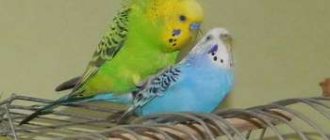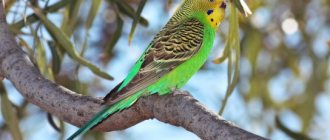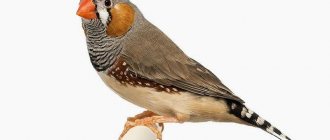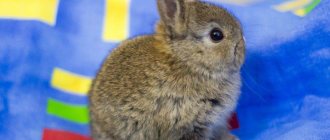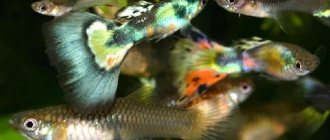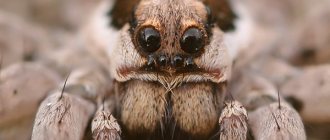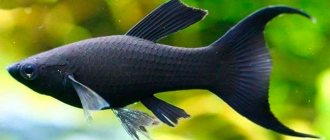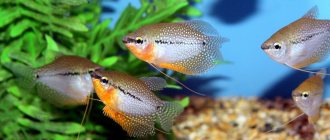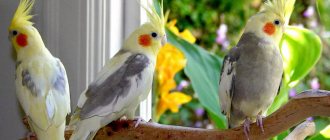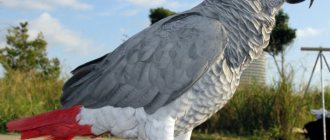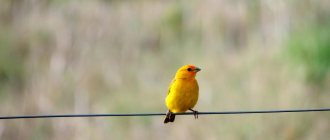People have long ago tamed budgerigars to live in captivity.
In 1850, in one of the zoos in Belgium, the offspring of parrots were obtained for the first time, and from that moment on, everyone had the opportunity not only to get themselves a budgerigar, but also to independently breed them, since, subject to certain conditions, it is enough to simply obtain offspring and thereby increase the number of stunning budgies.
In addition, all aspects of the life of budgies have been studied inside and out, therefore, there can be no problems with them if everything is done correctly.
Budgerigars become sexually mature approximately 5-7 months after birth.
However, this fact alone is not enough to successfully obtain offspring, since it is necessary to take into account certain factors that directly affect whether budgerigars will have offspring or not.
By the way, the most favorable age for reproduction is considered to be 2-4 years, since it is during this period of life that budgerigars have the best possible health, which allows them to reproduce productively.
By the way, the ability to reproduce in budgies remains for quite a long time, namely about 9 years on average.
- The best time to breed budgies
- Nesting house for budgerigars
- How does the breeding process of budgerigars occur?
Formation of a pair of birds
In order for the bird to have offspring, it is necessary to realize that the budgerigar is a flocking bird, and therefore the parrot must have sufficient space for mating and some choice among birds of its species.
When there are many birds in a cage, the formation of pairs is difficult to predict. The female always chooses and, as a rule, such pairs do not break up.
If you already have a male budgie, buy him a female at the age of 2-4 months.
It’s no secret that females dominate over males, and this way your pet will have the opportunity to tame the female “for himself.”
While the bird matures, it will have time to become attached to its partner and will not be able to show its character in full force.
Familiarize yourself with the varieties of budgies, learn how to care for budgies at home, how long these birds live at home and how they sing.
If you already have a one-year-old female in your house, and you are thinking about purchasing a male for her, opt for a male who has already established himself as a “dad”. Such a male is able to influence the character of the female and her absurd antics.
Only healthy (physically and psychologically) birds that have reached one year of age are selected for breeding. Birds must be selected from different nurseries to prevent mixing of relationships, which could result in genetically deformed chicks.
Video: selecting a pair for breeding budgerigars
For birds living in captivity, the optimal age for breeding is considered to be fourteen months. With proper care and proper maintenance, birds can reproduce until they reach ten years of age.
To prevent the appearance of weak or dead chicks, you should not mate an established pair more than twice a year.
Important! Overweight birds, those in the process of molting and birds with physical exhaustion are not allowed to lay eggs!
Food, light, nesting house
They say about budgerigars that they are undemanding birds. But during the breeding season they require special care.
The food is selected as varied as possible. Vitamin supplements are given in full. It is good to purchase a vitamin complex for nesting birds
It is important to prevent pets from becoming obese during this period.
Daylight hours are increased to 14 hours a day using lamp lighting. This encourages birds to nest.
How to support a couple and their offspring is an important question. For this you need a nesting house. This design is very similar to an ordinary birdhouse with a removable lid. The inside of the lower part must be lined with dry bark, hay, and twigs. The female will build a nest from them.
There lives a budgerigar, which has been carefully cared for and kept within the walls of the home for about 10 years. During this time, he will learn to speak and understand his owner. Communication with a pet will bring a lot of pleasure to a caring owner.
The best period for mating
The best period for mating is considered to be from June to September . At this time, the birds have enough vitamins, a sunny day, and air temperature.
At the beginning of spring, the parrots' body is weakened, they lack vitamins, and are unable to reproduce healthy offspring.
It happens that the appearance of chicks is expected in winter.
It is necessary to prepare for such masonry and improve conditions as much as possible:
- increase daylight hours up to 16 hours using special fluorescent lamps;
- maintain the room temperature at least +20 °C;
- organize enhanced nutrition for the female with the addition of fresh herbs at least twice a day.
Nutrition
The daily menu for parent parrots should be balanced, vitamin-rich and nutritious. Every day before breeding, parrots are fed:
- Grains and cereals;
- greens;
- vegetables;
- seeds;
- fruits;
- egg (preferably quail, but chicken can also be used);
- cottage cheese 2% fat;
- sprouted grains;
- mineral supplements;
- calcium (chalk or eggshells);
- porridge;
- steamed grains.
All food must be fresh, and any uneaten leftovers must be removed. The water must also be fresh, clean, and changed daily.
Parrots always need a varied diet, without reference to reproduction. It is necessary that the birds are accustomed to such a diet and calmly consume all products. If for birds a varied menu is a novelty and their usual diet is limited to 2-3 products, then breeding parrots will not only not be possible, but is also prohibited.
In order to produce healthy offspring, normally lay eggs and hatch them, and then feed the chicks, the bird needs a large amount of nutrients - a parrot with a meager or monotonous diet simply does not have enough of them. Even if the bird manages to lay eggs, the embryos in them will either be underdeveloped or have birth defects.
During the breeding season, the female parrot especially needs increased feeding, because it is her body that will have to form embryos, lay eggs and other stages of reproduction. To ensure the normal formation of the embryo and egg, it is recommended to additionally feed the birds every other day with a special gruel, which is a mixture of crushed ingredients:
- Carrots;
- sprouted grains;
- cottage cheese;
- eggs.
You should not feed birds this porridge more often than every other day. Otherwise, feeding will cause harm, not benefit. Due to the excess protein that this mixture is saturated with, the parrots will experience hormonal imbalance, the functioning of the gastrointestinal tract will be disrupted, and they will also become aggressive.
During the breeding season, it is important to monitor the consumption of wavy fish:
- Mineral stone;
- mineral mixture;
- sepia.
They should consume more of them than usual. If this does not happen, you will have to supply the birds with the necessary substances by mixing calcium gluconate into the food (available in tablets, you need to crush it into powder).
What should a cell be like?
For one pair of birds, a cage measuring 60*40*40 cm is suitable, for two pairs - twice as large. The design of the cage should be simple, made of durable material. It is desirable that the bottom of the cage extends, and it is possible to attach a nesting house to the side panels.
There are three types of bird houses: vertical house, horizontal house and compromise house. Whatever type of house you choose, it must have a folding or removable roof. This is necessary for timely inspection of the masonry, cleaning and disinfection of the nest.
Did you know? Budgerigars colonized Australia 5,000,000 years ago, during which time 200 species of these birds have survived.
Estimated costs
Breeding budgies at home requires certain investments, which consist of:
- costs of purchasing birds;
- costs for the purchase of cages, feeders, nesting boxes and other equipment;
- costs for feed and various vitamin supplements.
The approximate cost of all these purchases per pair of birds, male and female, is presented in the table.
| P/n | Cost, rub. |
| Budgerigars, 2 pcs. | 1000-1500 |
| Cage with feeder for 2 birds | 1000-1500 |
| Food, for 1 month | 150-200 |
| Vitamin supplements, per month | 50-100 |
Purchasing both the birds themselves and everything necessary for keeping and breeding them at a pet store will cost more than buying them secondhand or from breeders. Moreover, buying in bulk can provide even greater savings.
One pair, with normal breeding, is capable of producing 2-3 broods per year, each of which can have 4-10 chicks. Typically, private breeders can count on 500-600 rubles for each young parrot. Thus, one couple on average can generate an income of 5-20 thousand rubles per year. Obviously, to get more or less serious profits you need to take several pairs. But this, in turn, increases the effort and time spent caring for birds.
Breeding parrots usually requires virtually no additional costs, because the mineral supplements needed by the female caring for the chicks are inexpensive.
This calculation is very preliminary. After all, by purchasing several pairs at once, you can place them in one cage, which will be more expensive due to its large size, but will be cheaper per pair.
You may also be interested in the following business ideas:
- pet hotel
- how to open a pet grooming salon
- 24/7 veterinary assistance
- how to open a pet store from scratch
What conditions need to be created
Birds need to be prepared for breeding two to three weeks before the nesting house appears in the cage.
To do this you need:
- Gradually increase daylight hours to 15 hours . A sharp increase in daylight hours can cause parrots to molt, and such birds are not allowed to mate.
- Monitor the temperature in the room; they should not be lower than +20 °C , but excessively high temperatures are not recommended, as the birds’ body temperature will increase, and this will lead to the death of the embryo.
- Disinfect all objects with which the bird comes into contact : cage, feeders, drinking bowls, pet toys - immerse in hot water with a small addition of bleach, wash thoroughly with a brush, rinse thoroughly. The nesting house is disassembled into parts, disinfected with baby soap, dried and heated in the oven for 30 minutes at a temperature of +120 ° C; if the house is made of plastic, then it must be kept in the sun for at least six hours.
- You can add dry medicinal chamomile herb to the sawdust that is poured into the house ; it prevents the appearance of ticks and other parasites.
- The cage should be in a quiet and secluded place - preferably against a wall, at eye level. During the period while the parrots are nesting, it is advisable to reduce extraneous noisy sounds to nothing.
Did you know? The budgerigar is a rather talkative bird.
According to the Guinness Book of Records, Puck the parrot was recorded as having a vocabulary of 1,700 words! To properly appreciate the capabilities of a bird, this is the vocabulary the average five-year-old child has.
Chick development
The barely hatched chicks bear little resemblance to their handsome parents. The chicks are born weighing 1 g, blind and deaf. They have neither plumage nor even edges. They cannot hold their head up on their own and at first they just lie down.
Three-day-old chicks already weigh 4 g, but still lie. Further development occurs day by day according to the following schedule:
- 6th – raise their head, open their eyes;
- 8th – sit down;
- 10th – focus the gaze;
- 14th – pubescent;
- 18th - acquire the colors of the future plumage;
- 20th – acquire sexual characteristics;
- 24th – covered with tiny feathers, gaining maximum body weight;
- 29th – completely covered with feathers.
1-1.5 months after birth, the chicks fly out of the parent's nest. 2 weeks after this, they should be housed in separate cages.
What to feed
A parrot's diet should consist of more than just seeds, grains, fruits and vegetables. Its composition should include: greens, sprouted grains, cereals, calcium, mineral supplements, eggs and two percent cottage cheese.
The high content of vitamin E in pet food promotes their reproduction. It is vital that budgies eat all foods.
During nesting, the female needs increased nutrition, which is specially enriched with food and mineral supplements.
To get healthy offspring, many breeders feed their pets every other day with an enriched mixture: carrots, eggs, cottage cheese and sprouted grains.
Important! It is strictly forbidden to breed parrots from birds that eat only a few types of grains and have not tried anything else besides an apple and carrots.
The process of feeding chicks
From the moment the first chick hatches, the female should receive daily, in addition to regular food, an egg mixture (egg, carrots, semolina), millet, herbs, finely chopped vegetables and sprouted grains.
Dandelion leaves, spikelets of unripe millet, and green oats are very useful for budgies during this period.
The egg mixture should be given every day, because... Chicks need protein to grow. Newly hatched chicks receive nutrition in the first days of their lives from the female's crop jelly, which is formed in the muscular ventricle and is a mixture of protein-rich crop jelly with tiny particles of food. If there are a large number of chicks, the female first feeds the older chicks with grain from the crop, and when the grain supply runs out, she begins to feed the younger chicks with crop milk.
Feeding the couple with sprouted grain promotes the formation of milk, which is very important during the period of feeding the chicks.
At first, the male feeds the female, who leaves the nest only to defecate, drink some water and eat a little. Later, the chicks are fed by both parents alternately, and after the chicks first fledgling, they are usually fed only by the male, because the female is already preparing for the next clutch.
The most intense weight gain is observed in chicks in the first two days of life (almost 200%). At the age of 18 days, body weight growth slows down, and at the age of 23 days the chick reaches its maximum body weight.
Male courtship
The mating games that budgerigars demonstrate are quite a touching sight.
The male carefully cares for the female, trying to please her, tries to feed her, takes funny poses so that the chosen one will pay attention to him, makes amazing sounds, chatters (knocks with his beak on various objects, including the beak of the chosen one).
The desire to feed the female is the main indicator for the chosen one that the male is ready for a serious relationship, since it is he who will be the provider of food, the breadwinner for her while she hatches the eggs.
Did you know? It's hard to believe, but these birds can turn their heads 180
°
!
Buying parrots
If, after making all the preliminary calculations, you decide to start breeding budgies, then the first thing you need to do is purchase the birds.
To get healthy and beautiful offspring, it is necessary that the parents also have health. Therefore, it is undesirable to purchase from hands, as well as from unverified breeders. It is better to spend a little more money, but get guaranteed healthy birds.
The age of the future parents also matters. Peak reproduction in parrots occurs between 2 and 8 years of age. A young pair of parrots will produce offspring for several years, but older budgerigars will become useless from a breeding point of view after several nestings.
It is very important that the purchased male and female match each other. In budgerigars, sympathy or, on the contrary, antipathy plays a big role in the formation of a pair. If you choose the wrong pair, they may not have any offspring at all, or chicks will appear extremely rarely.
When buying two birds, you should choose an already established pair, in which the male is clearly courting the female, and she accepts these signs of attention. In addition, it is important to make sure that the birds purchased are of the opposite sex. There are often situations when the owners of purchased birds waited a long time for the offspring to appear and only after some time they learned that both of their pets were males.
When buying birds for breeding, the situation is made easier by the fact that in a flock, pairs form much faster and easier. After all, budgerigars are flocking birds, and the example of their relatives strengthens the reproductive instinct.
To obtain healthy offspring, it is necessary that the birds being bred do not have common ancestors. Therefore, it is not recommended to purchase all parrots for breeding from one breeder at once. This increases the chances that some birds will be related.
How many eggs does the female lay?
As a rule, the female lays eggs every other day. The number of eggs laid is affected by the age of the bird; most often there are about seven, sometimes more, although five eggs is considered the optimal number.
This is exactly the amount a female parrot can heat evenly. If there are more eggs in the clutch, then they can be placed in an incubator or placed on another pair of budgies.
Video: how to understand that a female budgerigar is pregnant
The appearance of chicks
The first chick appears in the nest 18-19 days after the start of incubation. You should not watch budgerigar chicks hatching, otherwise the female will become alarmed. The sacrament of birth occurs like this: cracks become visible on the shell, which gradually expand, and then the shell breaks in two. To crack the shell, the chick uses a bone growth on its beak - the so-called “egg tooth”. If the baby is weak, the female will help him break his way out of captivity.
Newborn chick
The birds appear one after another, most often in the same order as the eggs were laid. The number of eggs determines how many days the chicks will hatch. If 4 weeks have passed since the start of nesting, the remaining eggs can be removed - they will no longer hatch into chicks.
Care of offspring
Only the chicks that are born are not at all like their relatives: naked, blind, helpless. They are so weak that they are unable to hold their head, so they lie on their backs all the time.
It will be useful for you to read how to name a girl parrot or a boy parrot.
It is in this position that the female budgerigar feeds them; she is next to them all the time, warms the babies, and prevents them from freezing. The female parrot takes good care of her chicks, feeding them crop milk and grain.
Babies develop quite quickly. Judge for yourself: the weight of a newly hatched chick is 1 g, and two days later - 4 g. If the female hatches a clutch of more than 5 eggs, then there is a danger that the first grown chicks will crush the younger ones.
Did you know? In the natural environment, non-domesticated birds, like people, give their chicks names. In order to call them, they use a certain sound combination, to which the chicks respond.
The care that is required from a person at this time is to monitor the cleanliness of the nest and change the sawdust.
The first cleaning occurs two weeks after all the chicks have hatched, and then every week. Cleaning the bird's home must be done very quickly so that the chicks do not freeze and the female does not get too nervous.
Nesting period
The nesting period includes several important moments: from mating to the appearance of chicks. Depending on whether mating took place quickly or within two weeks, the wait for the young can last up to a month.
Pairing
Ornithologists note that mating of budgerigars can be one-time and sufficient for fertilization and the appearance of offspring. As a rule, the owners do not notice the rapid mating process. But sometimes mating games of budgies are repeated within 1-3 weeks.
Behavior of a pregnant female
After mating, the female's behavior begins to change. Ready to lay her eggs, she begins to familiarize herself with the nesting site. First, she looks at the nest from afar, stretching her neck. After some time, feeling that there is nothing to be afraid of, the female begins to slowly approach him. Depending on her character traits, sooner or later the female flies inside the house and begins to settle in there: gnawing on the walls and throwing out what, in her opinion, is unnecessary.
We recommend reading: How to choose the right budgie
Hatching offspring
It is necessary to ensure that none of the fertilized eggs is left unwarmed. Hatching lasts up to three weeks. If during this period some of the eggs do not hatch, they are removed. It happens that some chicks die after hatching. To detect and remove them, the house is checked 2-3 times a week.
Determination of egg quality
In simpler terms, this procedure is called ovoscopy. A week after laying, the eggs are checked. Fertilized ones have a matte tint, while unfertilized ones have some gloss in appearance and the color is mottled or yellowish-white.
Among the known defects are the following:
- blood clots in the egg;
- the embryo dries to the shell wall;
- the yolk and white are mixed;
- foreign objects enter the egg while still in the female’s oviduct;
- the air chamber in the egg moves;
- mold spots inside.
The appearance of chicks
The chicks are born blind and very weak. The body is completely naked, the opening of the eyes occurs after 6 or 7 days. But they can concentrate their gaze only 3 days later.
If a mother behaves aggressively towards her children, the babies are immediately removed. The female begins to leave the nesting site about two weeks after the chicks appear and returns to her usual quiet life.
The first chick hatches much earlier than the last one. The gradual laying of eggs is the reason for the extended hatching and maturation of the chicks.
When can chicks be separated from their parents?
The chicks are separated from their parents into another cage on the 3rd or 4th day after leaving the parental nest. As a rule, they should be 35 days old by this time.
In case of aggressive behavior of the female, the chicks are taken earlier, and if they are very young, they are placed on another pair of birds, and if they are already fledged, they are fed on their own.
You may be interested in reading about the features of keeping such parrots of such breeds as: Czechs, noble parrots, lorises, kakariks, drum parrots, monk parrots and kakapos.
First flight of chicks
Starting from the 24th day of life until the chick’s first flight from the nest, its weight decreases somewhat, which is explained by its energetic movements. As soon as the last chick flies out of the nest, the nest is carefully checked, as new clutches are often found there - eggs stained with droppings. They are transferred to a clean nest.
For an amateur, the flight of chicks is the moment of supreme pleasure. A chick sits on a branch, a little smaller than an adult parrot, with large dark eyes and amazingly examines the world around it. For the most part, the chicks fly nimbly and return to the nest already on the first day. Fully fledged, healthy chicks fly out of the nest at approximately 35 days of age. They are slightly smaller in size than their parents, the wavy on the head extends across the forehead to the base of the beak, and their coloring is less bright compared to their parents, their eyes are black, and there is a noticeable black spot at the tip of the beak. The cere and mandible of the chicks are pink, later – white with a bluish tint.
Chicks can be left with their parents in a cage for approximately 14 days after the last chick has fledged; They do not disturb subsequent nesting, since they no longer return to the nest. Then they need to be transplanted into a flying cage, where they fly freely, gradually turning into strong and healthy birds.
For a novice hobbyist who has hatched chicks for the first time, of course, there is a great temptation to look into the nest and see with his own eyes how the babies grow and develop. Usually the female reacts calmly to the owner’s intervention. Many birds remain calmly sitting on the clutch or brood, without particularly worrying. But it’s better not to do this, as there may be unpleasant consequences later in the form of pecked eggs or abandoned chicks. Therefore, in order to get a good look at everything, choose a moment when the bird is not there. Some birds become so accustomed to daily control by their owner that they even move aside or leave the nest.
Why there may be frozen or unfertilized eggs
It is considered normal for one or two eggs to freeze in a clutch. This happens to young females who do not yet have experience and simply could not warm up the entire clutch. It's another matter if the entire masonry died.
The cause of death may be:
- genetically incompatible parents;
- the inability of the female to hatch eggs normally;
- poorly formulated parrot nutrition;
- low quality water;
- infectious disease in birds;
- high temperature in an apartment with low humidity.
Unfertilized eggs occur when birds are not properly prepared for mating, or they signal that the bird has health problems.
The top 7 smartest parrot breeds include budgies, as well as grays, amazons, cockatoos, macaws, cockatiels and rosellas.
Successful breeding of budgies depends on careful preliminary preparation, attention to your pets and their health.
Budgerigars
Among the wide variety of parrot species, budgerigars have gained the greatest popularity. After all, they are small in size; their maintenance does not require special conditions of temperature and humidity. You can buy such a parrot for very little money, and the cost of the food consumed is quite low.
In addition, budgies have a cheerful and sociable disposition. They quickly get used to a person and behave quite sociably with him.
You can often find larger, exhibition budgies. These are larger individuals with unusual feather colors that are bred by breeders. Such parrots are valued much higher, but caring for exhibition breeds requires more complex care. Also, due to not very successful crossings, individuals are often found that are not capable of producing offspring. But healthy, full-fledged birds are much less fertile than ordinary budgies, and therefore are not suitable for breeding at the initial stage.
Typically, those breeders who have accumulated considerable experience and have an established clientele begin breeding larger and more expensive breeds of parrots . In this case, more expensive and rare birds become an addition to the usual budgies.

